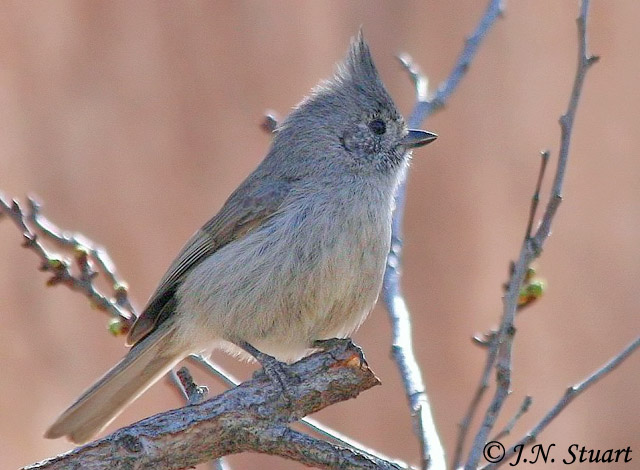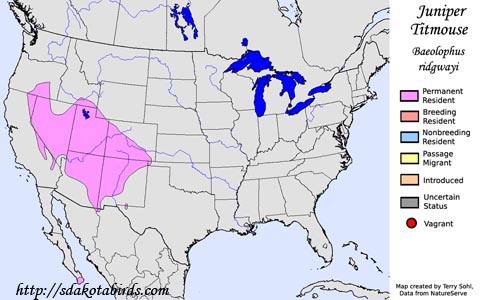| Length: 5.75 inches | Wingspan: 9 inches | Seasonality: Non-resident in South Dakota |
| ID Keys: Grayish overall, slightly lighter on underparts, small crest, very short stubby bill | ||
 The
JuniperTitmouse and the Oak Titmouse
used to be considered a single species, the "Plain Titmouse". The two
are very similar in appearance, but are separated by geographic range and
preferred habitat. The Juniper Titmouse is in drier juniper habitats of the inland southwestern
United States. The Oak Titmouse is found in warm, dry oak habitats,
near the coast or around the Central Valley of California. In
appearance, the two are very similar. However, the Juniper Titmouse is
typically "cooler" in color, lacking the brownish overtones to the grayish
plumage that the Oak Titmouse has.
The
JuniperTitmouse and the Oak Titmouse
used to be considered a single species, the "Plain Titmouse". The two
are very similar in appearance, but are separated by geographic range and
preferred habitat. The Juniper Titmouse is in drier juniper habitats of the inland southwestern
United States. The Oak Titmouse is found in warm, dry oak habitats,
near the coast or around the Central Valley of California. In
appearance, the two are very similar. However, the Juniper Titmouse is
typically "cooler" in color, lacking the brownish overtones to the grayish
plumage that the Oak Titmouse has.
Habitat: Found in open juniper woodlands, particularly during the breeding season. May utilize other nearby woodland habitats outside of the breeding season.
Diet: Feeds on insects, nuts, seeds, and berries. Feeds heavily on the seeds of pinyon juniper.
Behavior: Forages by moving actively through the woodland foliage, hopping from branch to branch and actively searching for insects.
Nesting: The Juniper Titmouse nests in cavities in trees, using either natural cavities or old woodpecker holes. The nest is lined with softer material such as grasses, feathers, or animal hair. The female lays between 5 and 8 eggs, and she alone incubates them. When the eggs hatch, both parents help to raise the young. The young leave the nest after about 18 days.
Song: The song of a Juniper Titmouse is a series of rapid whistled phrases, with phrases often given in groups of three.
Migration: Considered a permanent resident throughout its normal range.
Interactive eBird Map: Click here to access an interactive eBird map of Juniper Titmouse sightings
Similar Species: Oak Titmouse, Tufted Titmouse, Black-crested Titmouse
Feeders: Will attend feeders for various seeds and nuts, and for suet.
Conservation Status: Populations are considered stable, with no imminent threats to the species. The IUCN lists the Juniper Titmouse as a species of "Least Concern".
Further Information: 1) Audubon Guide - Juniper Titmouse
2) Whatbird - Juniper Titmouse
3) Wikipedia - Juniper Titmouse
Photo Information: Photo taken by J.N. Stuart - April 18th, 2008 - Near Santa Fe, New Mexico - Photo licensed under Creative Commons Attribution NonCommercial NoDerivs 2.0 Generic License
| Click below for a higher-resolution map |
 |
| South Dakota Status: Non-resident in South Dakota |
Additional Juniper Titmouse Photos (Coming soon!)
